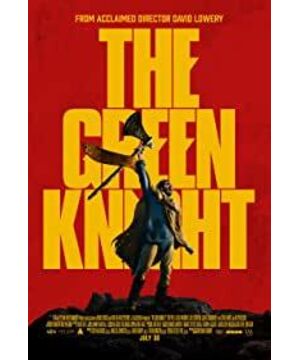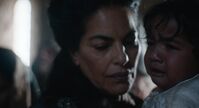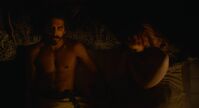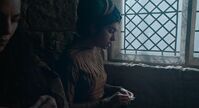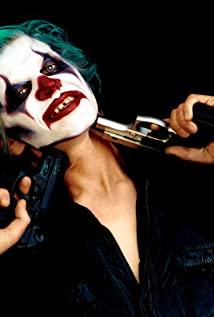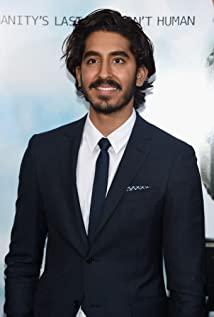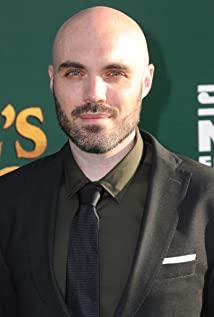This film makes me always want to take a small notebook to take notes, as if every frame and every pixel is an important test point. Unfortunately, after watching the whole movie, I couldn't interpret a single metaphor satisfactorily. My mind was full of fragmented thoughts and inspirations, and I just poured it on the table like a jigsaw puzzle.
Compared with the original long poem, the film has made many adaptations and added some original plots, which raises two questions: what is the purpose of the adaptation? What is the significance of the original plot? The summary of the original poem is as follows (source Wikipedia)
first part
The whole story takes place on the eve of Christmas Eve in Camelot . When King Arthur and the Knights of the Round Table celebrated the 15th New Year's Day in the palace hall , something unexpected happened. At the celebration banquet that night, there was a The mighty and tall knight in green armor rushed into the hall on a green horse, and everyone was stunned. I saw the green knight holding holly in one hand and an axe in the other, threatening to challenge the knights of King Arthur to see which knight dared to cut off his head with an axe, and asked whoever cut his head off. On New Year's Day of the second year, I must go to an appointment to receive his axe. Gawain volunteered to accept the challenge of the unknown green knight. Gawain quickly flew his axe and successfully cut off the green knight's head. The knight did not fall to the ground and died because his head was cut off, but leaned over to pick up his own head, then pointed his head at Gawain, and asked Gawain to go to the Green Church to find him on New Year's Day the following year. and accept his cutback.
the second part
Before he knew it, the winter of the second year came, and Gawain had to obey the agreement with the Green Knight and go to the Green Church to accept his challenge. Before leaving, King Arthur held a banquet with all the knights to see Gawain off in order to celebrate Gawain's safe return. In order to fulfill his promise, Gao Wen traveled all the way through mountains and rivers, over mountains and mountains, not only suffering from hunger and cold, but also at the risk of encountering jackals and wild beasts. , he discovered an ancient castle, where he was warmly received by the castle owner and his wife. Gawain learned from them that the Green Church he was going to was not far from here, and temporarily left him to live in the castle. But the master had a condition for Gawain, that is, the master went out hunting during the day, and at night he would exchange the prey with Gawain's items, and Gawain agreed to the master's request.
the third part
When the castle owner was out hunting, the beautiful lady in the castle waited for the opportunity to show her love to Gawain, but was immediately rejected by Gawain. When the master gave the prey to Gawain at night, Gawain just kissed the master once in return, and the next day he kissed the master twice. Until the third day, his wife gave him a very special ring, but Gawain also refused. The wife then gave him a green belt, claiming that as long as he wears this belt, he will be invulnerable. Gawain suddenly remembered his axe contract with the Green Knight, so he changed his mind and agreed to accept this green belt from his wife. When exchanging gifts with the master at night, Gawain did not give the green belt to the master as a return gift, but kissed the master five times.
fourth part
Gawain finally left the castle and marched all the way to the Green Church under the guidance of the elf guide. When he was about to reach the Green Church, he was walking alone, and occasionally heard the sound of an axe sharpening in front of him, Gawain leaned towards the sound, and soon the green knight appeared in front of him, and he picked up the axe and chopped at his head. Gawain retracted his head in fear, and the green knight angrily yelled at him for being timid; the second axe, Gawain, did not dodge and let him slash, but the green knight did not directly hurt him; then the third axe only slashed. Gawain scratched his scalp a little, only a little blood shed. When the green knight lifted the axe and slashed at him again, Gawain jumped up and demanded the green knight to stop attacking immediately. At this time, the Green Knight revealed his true colors, and it turned out that he was the owner of the castle. The reason is mainly to test whether Gawain follows the noble way of the knight. The first two axes did not hurt Gawain on behalf of Gawain for not breaking the agreement between them during the first two nights at the castle, and the third axe hurt him because he did not hand over the green belt given by his wife on the third night. After Gawain returned to Camelot, he told the whole story truthfully, and then King Arthur proposed that all the knights of the round table and court women wear green belts as a commemoration of this event. What Gawain and all the people of Camelot did not know was that all of this was a trap set up by Lady Morgan le Fay in order to make King Arthur's most elite knight the Green Knight of the "Goddess" (Morgan le Fay).
It can be found that in the original text, it was the evil witch Morgan Leffey who cast the spell to create the Green Knight, and she was also King Arthur's half-sister and Sir Gawain's aunt. The purpose was to challenge the Knights of the Round Table and hope that the Green Knight could be cut down. Talking heads can scare sister-in-law Queen Guinevere to death. In the movie, the caster was changed to Gawain's mother (and possibly Gawain's mother to Morgan Le Fay), which changed the whole story. After Gawain admits to his uncle, King Arthur, that he has no heroic stories to tell, the Green Knight comes on the scene, turning it from a conspiracy against King Arthur and the Knights of the Round Table into a self-directed and self-acted con to help his son create a legend; There will be cowards, but the elites have the ability to pack offspring.
Gawain's adventures on the way to find the Green Church are all original films, and they are also the most symbolic passages, and even the most difficult to interpret. Sir Gawain was unfavorable in his apprenticeship. After walking a few steps, he was tricked into a trap by bandits and lost all his equipment. This passage can be seen as a mockery of the elites and a de-romanticization of knight heroes. It can also be seen as It is the experience of the protagonist who is still young and innocent, and the only way to grow from a boy to a man. An interesting part of this section is a long shot that surrounds the forest to a corpse and then turns back. Usually such a long shot indicates the passage of time. I once thought that the corpse belonged to Gawain, but Gawain died in an unknown deep forest. The bandit boy completed the journey and the challenge of the green knight instead of him and became a legend. Later, I found out that I think the corpse was the previous victim. This detail may only be to show the cruelty of the bandits and increase the sense of crisis that Gawain escaped. and urgency.
The long poem mentions that Gawain passed the holy hede on his journey. Many scholars believe that it refers to holywell, the place in the legend of St. Winifred. In the legend, St. Winifred was beheaded by Caradog, the unsuspecting suitor, and his head rolled into it. A glance into the healing spring water. Beuno, the saint who witnessed the incident, fished her head from the spring to help her bring her back to life, and then prayed to God for punishment to send Caradog to hell. The film transfers the story of Winifred, which was two centuries earlier, to Gawain, and the meaning may lie in the two key words of "seeking a head" and "not asking for a reward". The first conversation between Gawain and Winifred said that he was going to go home, which means that after being robbed by bandits, he was ready to give up looking for the Green Knight to complete the one-year contract, but after helping Winifred to find his head, he also seemed to be looking for him. After regaining a little courage and reason, I still embarked on the journey to the Green Church. Retrieving the Green Knight's axe after not getting Winifred's promise of a reward for finding the head but still going into the water, reminds me of the fable of the golden axe and the silver axe (this explanation is too far-fetched for me to say it first). In this scene, the fox officially appears. I have several guesses about the identity and role of this fox, but I will not list it first.
The house leak happened to rain overnight. Gao Wen, who was struggling to move forward in the cold wind and rain, slipped down a steep slope. After eating wild mushrooms, he unfortunately ate poisonous mushrooms and suddenly walked into the set of "Attack on Titan". The giant who appeared here Whether it is the hallucination caused by eating mushrooms or the real existence, I am uncertain: On the one hand, although there is no detail in the original poem, it is mentioned that Gao Wen encountered the ogres (Ogres), in my concept it should be Like creatures like the Orcs in Lord of the Rings, the abandonment of trolls in folklore should not be an unintentional adaptation. The giants in the movie are less like evil and dangerous hostile creatures and more like a natural wonder. In the anti-traditional knight hero story, all non-me races are depicted as evil forces to act in their own way, subverting the inherent superiority of human beings as God's favorite over nature and other creatures, with the extraordinary magnificence of giants. Contrasting the insignificance of human beings. I've had "maybe Gawain's encounter with the giant taught him to respect nature and humble himself", but felt at odds with his request to ride on the shoulders of giants (I don't want to pass up the chance to tell this joke: entitled white women are called Kare, what do we call entitled white men? -- White men. )
I finally reached the last stop in front of the Green Church. In the original text, Gawain rested and adjusted for a few days. The castle owner went out hunting for a few days, but the castle owner’s wife failed to seduce him several times. In the movie, this process is greatly shortened. The beautiful lady gave Gawain a quick hand job while giving the belt. I thought no, no, no, he won't give the castle owner a hand job in return. What movie are you watching? As a result, this Gawain was not honest, not only did he drop the belt, but even that kiss was taken back by the castle owner on his own initiative. Seeing Gawain running away, I was a little disappointed and nervous. In the original text, Gawain did not return the belt, which caused the Green Knight's third blow to cut his neck, but the Green Knight explained that he accepted and kept it. The belt was justifiable because Gawain was worried about his own life, so he just cut his neck as punishment. But what happens to this unreturned hand job in the movie is unknown. On the other hand, there is a claim that there is a homoerotic undertone in a series of stories of King Arthur. I guess the director and screenwriter also support this opinion, so this ambiguous writing style is made clear with a small change. The chain reaction caused by this change is that Gawain arrived at the Green Church ahead of schedule, rather than on the agreed day as written in the original text, so that Gawain had to sit in the Green Church for two days. I have a theory on the meaning of this move. I can't hold back either, maybe it's just because the movie is too long to catch up.
Gawain in the original poem is a hero with high moral character from beginning to end, but in the film, Gawain went from being a lazy, not very brave, somewhat naive libertine to finally taking off his magic belt, between honesty and the green knight. In my opinion, the arc of this character makes this character more human and courageous. As for whether the Green Knight has a fatal blow in the end, I don't think it matters anymore. The legend that belongs to Sir Gawain has been written. .
=================================Some sporadic problems================ =================
The role of the fox: In the original text, the fox stopped Gawain by the river was said by the castle master to Gawain's guide, because the castle master is the green knight, so he set up such a test to try to shake Gawain's courage and determination It makes sense, but the fox had been guiding and accompanying him along the way, but at the last moment he persuaded Gawain to give up on fulfilling his agreement. Such a contradictory setting made me think that the fox was the outward expression of Gawain's inner struggle: The moment the fox appeared was when Gawain decided not to give up halfway and go home but to continue the journey. When he was lonely and afraid in the wild, he accompanied him as a companion. When Gawain entered the castle to relax, the fox disappeared, and he said goodbye to the hospitable castle. The owner reappeared when he was alone on the road (in the original text, the castle owner hunted back a fox on the last day, which corresponds to being captured by the castle owner in the movie), and when he was about to face the green knight and the seemingly inevitable death, the fox suddenly opened his mouth to persuade He runs away. Another guess I have is that the fox is the guardian who summoned Gawain to protect Gawain, so when Gawain did not meet the conditions for success in the challenge and was ready to face the Green Knight, he would only speak out to stop him.
what happened to the bandit boy? The green knight's axe may have insane magic, so after robbing Gawain, he suddenly said that he wanted to help Gawain complete the promise and ran away. Although he didn't know what happened to Gawain while he was walking, but from Gawain's walk. A scene in the last foreseen future can be found where he seems to be wandering in a trance. I guess that after the axe was returned to Gawain by the Holy Maiden, he was affected by magic and forgot about this period of experience. Or maybe he successfully reached the Green Church and was beheaded by the Green Knight, but because he wore the protective belt woven by Gawain's mother, his head did not fall off, but he would also be decapitated and die once he took off the belt like King Gawain. , but the movie seems to imply that the green knight will only wake up from a slumber exactly a year later, so I don't think this hypothetical possibility is very high
View more about The Green Knight reviews


